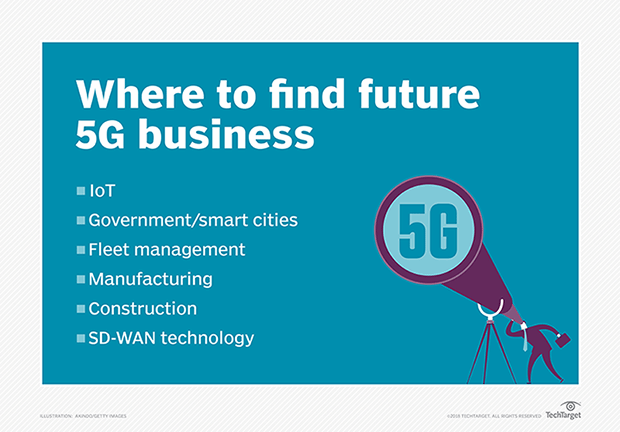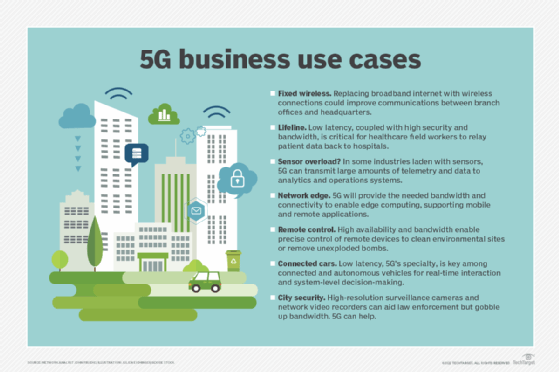5 predictions about 5G adoption in 2025 and beyond
You can distill the biggest predictions about the future of 5G into one big prediction: By 2027, 5G will overtake 4G as the dominant technology.
5G is picking up speed, both figuratively and literally. The future of 5G is bright if the latest predictions prove true.
In 2020, Apple released the first iPhones to support 5G connectivity, working with both mmWave and sub-6 GHz 5G. AT&T and Verizon both announced that their 5G service is available nationwide, with Verizon also indicating that its 5G Ultra Wideband service (up to 4 Gbps) is available in parts of 71 cities. T-Mobile, which acquired Sprint in April 2020, added 2,000 towns and cities to its 5G network with the launch of its independent architecture. This increased the total of cities covered to over 7,500.
But the more exciting aspects of 5G are yet to come, as the collection of technologies known as 5G become an integral part of the retail experience, fixed wireless access, manufacturing, healthcare, mobility -- and woven throughout IoT.
First, though, consider the scope of the overall growth. The "2024 Ericsson Mobility Report" pegs global 5G mobile subscriptions at 2.3 billion at the end of 2023. The report forecasts 5G subscriptions to reach 6.3 billion globally by the end of 2030, accounting for approximately 67% of total global mobile subscriptions at that time. (It should be noted that while Ericsson as a communications technology provider has a vested interest in painting a rosy picture of 5G, its oft-cited Mobility Report is well respected.) Ericsson Mobility predicts that 5G will overtake 4G as the dominant technology by 2027.
International Data Corp's. (IDC) "U.S. 5G Smartphone Forecast, 2023-2027" forecasts that by 2027, 155.0 million 5G smartphone units will ship in the U.S.
GSMA Intelligence puts 5G growth at 5.5 billion 5G connections by 2030. In North America alone, GSMA forecasts that by 2030, 90% of mobile connections will be 5G. 5G Americas, which is a telecommunications industry trade organization, has a more aggressive forecast, projecting 7.9 billion 5G connections by 2028.
Regardless of the numbers realized, the growth will come at great cost. McKinsey and Co. predicts that by 2030 only one-quarter of the world's population will have access to high-band 5G coverage. That means that while 5G coverage will be greatly expanded, that expansion will cover much of the edge. In a February 2023 report, McKinsey wrote that telecommunication providers were expected to invest approximately $600 billion in 5G infrastructure between 2022 and 2025 alone.
"Enthusiasm alone, however, will not allow telcos to recoup their investments in 5G, let alone thrive in a rapidly evolving landscape," the McKinsey report stated. "In the United States alone, telcos spent roughly $100 billion to purchase 5G spectrum at auction in 2021. Despite these substantial infrastructure investments, the adoption and monetization of 5G are still in their infancy."
How retail will benefit from 5G
Retail is anticipated to be one of the greatest beneficiaries of 5G by the end of the decade, especially in more populous areas where 5G coverage is expected to flourish and complement smart retail technology, such as shelf sensors, cashier-less checkout and QR codes.
IHS Markit explained in its November 2019 report how 5G will contribute to the global economy. The report states that brick-and-mortar retailers could use 5G -- in conjunction with ultra-high definition (UHD) video, virtual reality and augmented reality -- to differentiate themselves in digital signage as a way of competing more effectively with online shopping. That would come in the form of greater in-store digital interaction with customers.
Forrester Research said that the benefit to retail will come as building blocks "to frictionless end-to-end consumer experiences in the form of enhanced mobile broadband; massive machine-type communications (MTC) and ultra-reliable, low-latency communications." MTC provides connections to numerous devices that intermittently transmit small amounts of traffic. 5G mobile broadband will also facilitate virtual and remote support before, during and after a sale, including VR and AR services, smart screens and mobile cloud services, Forrester said.
5G communications will also boost retail supply chain transparency and efficiency as IoT sensors become ubiquitous, Forrester said. Mordor Intelligence has forecast that the 5G IoT market should hit $75.08 billion by 2029.

Demand is building for 5G manufacturing
Using analytics, artificial intelligence and advanced robotics in smart factories can have a major impact on overall plant performance, McKinsey said. The findings show that smart factories can improve operational efficiency at every stage of production -- both on a single assembly line, as well as across multiple facilities. Industry will increasingly do this using low-latency and private 5G networks, according to analysts.
As industries consider their 5G options, they'll have the option of building and controlling a private 5G network using their own spectrum, or to procure a network slice from a provider's public 5G wireless network.
Private 5G has a strong growth trajectory for IoT, with global private 5G set to grow at 65.4% CAGR to 2030. ResearchAndMarkets forecasts the private 5G network market will be worth $22.9 billion by 2029.
PWC forecasts 5G-powered industrial manufacturing will help boost global GDP by as much as $billion by 2030.
5G will change healthcare from head to toe
5G will certainly revolutionize every aspect of healthcare, from supply chain optimization to remote diagnostics to electronic medical records management. PwC forecasts the global GDP impact of 5G in healthcare will hit $530 billion by 2030. PwC foresees 5G-compatible devices being used to monitor bed occupancy levels, the movement of physicians, nurses and patients around the hospital, and wearable medical devices.
The biggest change will come through haptic communications and what has become known as the tactile internet. The International Telecommunication Union described the tactile internet as one that combines ultra-low latency with extremely high availability, reliability and security. The tactile internet will enable a physician to perform a procedure on a remote patient. PwC envisioned it like this: "The surgeon's movements at one site would be recreated instantaneously by computerized equipment at the other site, an innovation that could particularly benefit patients in rural areas or smaller regions, where surgeons specializing in complex procedures may not be readily available."

Fixed wireless access will gain traction
Fixed wireless access (FWA), which had been eschewed by critics as redundant to fiber, uses 5G to provide broadband internet services to homes that cannot get -- or choose not to get -- wireline service. The main benefit, GSMA said, is that it can deliver average speeds similar to fiber-based services at about one-quarter the cost.
"For customers, the advent of 5G means that previously unconnected households and communities will realize the benefits of higher speeds, capacity and bandwidth to support their increasing number of IoT devices," GSMA stated in its November 2019 report "The Internet of Things in the 5G Era."
FWA has become one of the leading use cases for 5G New Radio. 5G NR is a set of standards that replace the LTE network 4G wireless communications standard. Fiber equivalent bandwidth transmissions are supported by 5G NR for applications such as streaming video and low-bandwidth transmissions in massive (M2M) communication. 5G NR also handles vehicle-to-vehicle (V2V) and vehicle-to-infrastructure (V2I) transmissions with an extremely low latency demand.
FWA subscribers will require new customer premises equipment (CPE). GSA 4G/5G Fixed Wireless Access Forum reported 5G CPE shipments hit 37.5 million units in 2024. ABI Research has forecast that there will be 265 million FWA subscriptions globally by 2029, with 5G FWA expected to account for 45% of that total.
5G beyond 2025
5G promises to bring the world to our mobile devices as we walk from point A to point B. However, the real excitement is what 5G brings to intelligent mobility systems -- car-sharing services, public transport, V2I and V2V, and shipping and receiving. Add to that list smart cities that can use 5G to improve operational efficiency, share information with the public and improve both the quality of government services and citizen welfare. That includes improving traffic flow.
5G also has tremendous potential for enterprises. Among the uses where 5G is likely to have a large effect is with Citizen Broadband Radio Service (CBRS) and private networks. GMI has forecast the market for 5G-based CBRS could reach $5.7 billion by 2032. According to Exactitude Consultancy, the global 5G enterprise market will reach $34.4 billion by 2032.
JPMorgan forecasts for 5G are also very strong, with enterprise opportunities helping to accelerate growth. In North America alone, JPMorgan forecasts that 5G will generate $180 billion by 2030.
"The biggest opportunity for 5G is in enterprise," wrote Samik Chatterjee, a telecom and network equipment/IT hardware senior analyst at JPMorgan, in a report. "Companies have only just started to scratch the surface in terms of investing in enterprise use cases."
The overall total effect of 5G around the world is a massive number to comprehend. According to PwC, the total global effect of 5G by 2030 will reach $1.3 trillion.
In 2025 and beyond as 5G continues to mature, so too do efforts to standardize its successor -- 6G. Efforts to define the 6G specifications will continue in 2025, with the standard not expected to be completed until 2028.
Sean Michael Kerner is an IT consultant, technology enthusiast and tinkerer. He has pulled Token Ring, configured NetWare and has been known to compile his own Linux kernel. He consults with industry and media organizations on technology issues.
Kevin Ferguson has written about technology for many years and for many publications. He is a regular contributor to TechTarget. He has also produced radio and film for NPR and PBS. Kevin holds a B.A. in journalism from Rutgers University and an MPA from Harvard University.




